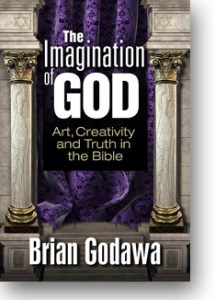In Darren Aronofsky’s new star-gilt silver screen epic, Noah, Adam and Eve are luminescent and fleshless, right up until the moment they eat the forbidden fruit.
Such a notion isn’t found in the Bible, of course. This, among the multitude of Aronofsky’s other imaginative details like giant Lava Monsters, has caused many a reviewer’s head to be scratched. Conservative-minded evangelicals write off the film because of the “liberties” taken with the text of Genesis, while a more liberal-minded group stands in favor of cutting the director some slack. After all, we shouldn’t expect a professed atheist to have the same ideas of “respecting” sacred texts the way a Bible-believer would.
Both groups have missed the mark entirely. Aronofsky hasn’t “taken liberties” with anything.
The Bible is not his text.
In his defense, I suppose, the film wasn’t advertised as such. Nowhere is it said that this movie is an adaptation of Genesis. It was never advertised as “The Bible’s Noah,” or “The Biblical Story of Noah.” In our day and age we are so living in the leftover atmosphere of Christendom that when somebody says they want to do “Noah,” everybody assumes they mean a rendition of the Bible story. That isn’t what Aronofsky had in mind at all. I’m sure he was only too happy to let his studio go right on assuming that, since if they knew what he was really up to they never would have allowed him to make the movie.
Let’s go back to our luminescent first parents. I recognized the motif instantly as one common to the ancient religion of Gnosticism. Here’s a 2nd century A.D. description about what a sect called the Ophites believed:
“Adam and Eve formerly had light, luminous, and so to speak spiritual bodies, as they had been fashioned. But when they came here, the bodies became dark, fat, and idle.” –Irenaeus of Lyon, Against Heresies, I, 30.9
It occurred to me that a mystical tradition more closely related to Judaism, called Kabbalah (which the singer Madonna made popular a decade ago or so), surely would have held a similar view, since it is essentially a form of Jewish Gnosticism. I dusted off (No, really: I had to dust it) my copy of Adolphe Franck’s 19th century work, The Kabbalah, and quickly confirmed my suspicions:
“Before they were beguiled by the subtleness of the serpent, Adam and Eve were not only exempt from the need of a body, but did not even have a body—that is to say, they were not of the earth.”
Franck quotes from the Zohar, one of Kabbalah’s sacred texts:
“When our forefather Adam inhabited the Garden of Eden, he was clothed, as all are in heaven, with a garment made of the higher light. When he was driven from the Garden of Eden and was compelled to submit to the needs of this world, what happened? God, the Scriptures tell us, made Adam and his wife tunics of skin and clothed them; for before this they had tunics of light, of that higher light used in Eden…”
Obscure stuff, I know. But curiosity overtook me and I dove right down the rabbit hole.
I discovered what Darren Aronofsky’s first feature film was: Pi. Want to know its subject matter? Do you? Are you sure?
Kabbalah.
If you think that’s a coincidence, you may want a loved one to schedule you a brain scan.
Have I got your attention? Good.
The world of Aronofsky’s Noah is a thoroughly Gnostic one: a graded universe of “higher” and “lower.” The “spiritual” is good, and way, way, way “up there” where the ineffable, unspeaking god dwells, and the “material” is bad, and way, way down here where our spirits are encased in material flesh. This is not only true of the fallen sons and daughters of Adam and Eve, but of fallen angels, who are explicitly depicted as being spirits trapped inside a material “body” of cooled molten lava.
Admittedly, they make pretty nifty movie characters, but they’re also notorious in Gnostic speculation. Gnostics call them Archons, lesser divine beings or angels who aid “The Creator” in forming the visible universe. And Kabbalah has a pantheon of angelic beings of its own all up and down the ladder of “divine being.” And fallen angels are never totally fallen in this brand of mysticism. To quote the Zohar again, a central Kabbalah text: “All things of which this world consists, the spirit as well as the body, will return to the principle and the root from which they came.” Funny. That’s exactly what happens to Aronofsky’s Lava Monsters. They redeem themselves, shed their outer material skin, and fly back to the heavens. Incidentally, I noticed that in the film, as the family is traveling through a desolate wasteland, Shem asks his father: “Is this a Zohar mine?” Yep. That’s the name of Kabbalah’s sacred text.
The entire movie is, figuratively, a “Zohar” mine.
If there was any doubt about these “Watchers,” Aronofsky gives several of them names: Semyaza, Magog, and Rameel. They’re all well-known demons in the Jewish mystical tradition, not only in Kabbalah but also in the book of 1 Enoch.
What!? Demons are redeemed? Adolphe Franck explains the cosmology of Kabbalah: “Nothing is absolutely bad; nothing is accursed forever—not even the archangel of evil or the venomous beast, as he is sometimes called. There will come a time when he will recover his name and his angelic nature.”
Okay. That’s weird. But, hey, everybody in the film seems to worship “The Creator,” right? Surely it’s got that in its favor!
Except that when Gnostics speak about “The Creator” they are not talking about God. Oh, here in an affluent world living off the fruits of Christendom the term “Creator” generally denotes the true and living God. But here’s a little “Gnosticism 101” for you: the Creator of the material world is an ignorant, arrogant, jealous, exclusive, violent, low-level, bastard son of a low level deity. He’s responsible for creating the “unspiritual” world of flesh and matter, and he himself is so ignorant of the spiritual world he fancies himself the “only God” and demands absolute obedience. They generally call him “Yahweh.” Or other names, too (Ialdabaoth, for example).
This Creator tries to keep Adam and Eve from the true knowledge of the divine and, when they disobey, flies into a rage and boots them from the garden.
In other words, in case you’re losing the plot here: The serpent was right all along. This “god,” “The Creator,” whom they are worshiping is withholding something from them that the serpent will provide: divinity itself.
The world of Gnostic mysticism is bewildering with a myriad of varieties. But, generally speaking, they hold in common that the serpent is “Sophia,” “Mother,” or “Wisdom.” The serpent represents the true divine, and the claims of “The Creator” are false.
So is the serpent a major character in the film?
Let’s go back to the movie. The action opens when Lamech is about to bless his son, Noah. Lamech, rather strangely for a patriarch of a family that follows God, takes out a sacred relic, the skin of the serpent from the Garden of Eden. He wraps it around his arm, stretches out his hand to touch his son—except, just then, a band of marauders interrupts them and the ceremony isn’t completed. Lamech gets killed, and the “villain” of the film, Tubal-Cain, steals the snakeskin. Noah, in other words, doesn’t get whatever benefit the serpent’s skin was to bestow.
The skin doesn’t light up magically on Tubal-Cain’s arm, so apparently he doesn’t get “enlightened,” either. And that’s why everybody in the film, including protagonist and antagonist, Noah and Tubal-Cain, is worshiping “The Creator.” They are all deluded. Let me clear something up here: lots of reviewers expressed some bewilderment over the fact there aren’t any likable characters and that they all seem to be worshiping the same God. Tubal-Cain and his clan are wicked and evil and, as it turns out, Noah’s pretty bad himself when he abandons Ham’s girlfriend and almost slays two newborn children. Some thought this was some kind of profound commentary on how there’s evil in all of us. Here’s an excerpt from the Zohar, the sacred text of Kabbalah:
“Two beings [Adam and Nachash—the Serpent] had intercourse with Eve [the Second woman], and she conceived from both and bore two children. Each followed one of the male parents, and their spirits parted, one to this side and one to the other, and similarly their characters. On the side of Cain are all the haunts of the evil species; from the side of Abel comes a more merciful class, yet not wholly beneficial — good wine mixed with bad.”
Sound familiar? Yes. Darren Aronofsky’s Noah, to the “T.”
Anyway, everybody is worshiping the evil deity. Who wants to destroy everybody. (By the way, in Kabbalah many worlds have already been created and destroyed.) Both Tubal-Cain and Noah have identical scenes, looking into the heavens and asking, “Why won’t you speak to me?” “The Creator” has abandoned them all because he intends to kill them all.
Noah had been given a vision of the coming deluge. He’s drowning, but sees animals floating to the surface to the safety of the ark. No indication whatsoever is given that Noah is to be saved; Noah conspicuously makes that part up during an awkward moment explaining things to his family. He is sinking while the animals, “the innocent,” are rising. “The Creator” who gives Noah his vision wants all the humans dead.
Many reviewers thought Noah’s change into a homicidal maniac on the ark, wanting to kill his son’s two newborn daughters, was a weird plot twist. It isn’t weird at all. In the Director’s view, Noah is worshiping a false, homicidal maniac of a god. The more faithful and “godly” Noah becomes, the more homicidal he becomes. He is becoming every bit the “image of god” that the “evil” guy who keeps talking about the “image of god,” Tubal-Cain, is.
But Noah fails “The Creator.” He cannot wipe out all life like his god wants him to do. “When I looked at those two girls, my heart was filled with nothing but love,” he says. Noah now has something “The Creator” doesn’t. Love. And Mercy. But where did he get it? And why now?
In the immediately preceding scene Noah killed Tubal-Cain and recovered the snakeskin relic: “Sophia,” “Wisdom,” the true light of the divine. Just a coincidence, I’m sure.
Okay, I’m almost done. The rainbows don’t come at the end because God makes a covenant with Noah. The rainbows appear when Noah sobers up and embraces the serpent. He wraps the skin around his arm, and blesses his family. It is not God that commissions them to now multiply and fill the earth, but Noah, in the first person, “I,” wearing the serpent talisman. (Oh, and by the way, it’s not accidental that the rainbows are all circular. The circle of the “One,” the Ein Sof, in Kabbalah, is the sign of monism.)
Notice this thematic change: Noah was in a drunken stupor the scene before. Now he is sober and “enlightened.” Filmmakers never do that by accident.
He’s transcended and outgrown that homicidal, jealous deity.
Let me issue a couple of caveats to all this: Gnostic speculation is a diverse thing. Some groups appear radically “dualist,” where “The Creator” really is a different “god” altogether. Others are more “monist,” where God exists in a series of descending emanations. Others have it that the lower deity “grows” and “matures” and himself ascends the “ladder” or “chain” of being to higher heights. Noah probably fits a little in each category. It’s hard to tell. My other caveat is this: there is no doubt a ton of Kabbalist imagery, quotations, and themes in this movie that I couldn’t pick up in a single sitting. For example, since Kabbalah takes its flights of fancy generally based on Hebrew letters and numbers, I did notice that the “Watchers” appeared to be deliberately shaped like Hebrew letters. But you could not pay me to go see this movie again so I could further drill into the Zohar mine to see what I could find. (On a purely cinematic viewpoint, I found most of it unbearably boring.)
What I can say on one viewing is this:
Darren Aronofsky has produced a retelling of the Noah story without reference to the Bible at all. This was not, as he claimed, just a storied tradition of run-of-the-mill Jewish “Midrash.” This was a thoroughly pagan retelling of the Noah story direct from Kabbalist and Gnostic sources. To my mind, there is simply no doubt about this.
So let me tell you what the real scandal in all of this is.
It isn’t that he made a film that departed from the biblical story. It isn’t that disappointed and overheated Christian critics had expectations set too high.
The scandal is this: of all the Christian leaders who went to great lengths to endorse this movie (for whatever reasons: “it’s a conversation starter,” “at least Hollywood is doing something on the Bible,” etc.), and all of the Christian leaders who panned it for “not following the Bible”…
Not one of them could identify a blatantly Gnostic subversion of the biblical story when it was right in front of their faces.
I believe Aronofsky did it as an experiment to make fools of us: “You are so ignorant that I can put Noah (granted, it’s Russell Crowe!) up on the big screen and portray him literally as the ‘seed of the Serpent’ and you all will watch my studio’s screening and endorse it.”
He’s having quite the laugh. And shame on everyone who bought it.
And what a Gnostic experiment! In Gnosticism, only the “elite” are “in the know” and have the secret knowledge. Everybody else are dupes and ignorant fools. The “event” of this movie is intended to illustrate the Gnostic premise. We are dupes and fools. Would Christendom awake, please?
In response, I have one simple suggestion:
Henceforth, not a single seminary degree is granted unless the student demonstrates that he has read, digested, and understood Irenaeus of Lyon’s Against Heresies.
Because it’s the 2nd century all over again.
Postscript
Some readers may think I’m being hard on people for not noticing the Gnosticism at the heart of this film. I am not expecting rank-and-file viewers to notice these things. I would expect exactly what we’ve seen: head-scratching confusion. I’ve got a whole different standard for Christian leaders: college and seminary professors, pastors, and Ph.Ds. If a serpent skin wrapped around the arm of a godly Bible character doesn’t set off any alarms… I don’t know what to say.
To view the article on the author’s website click here – Dr. Brian Mattson


